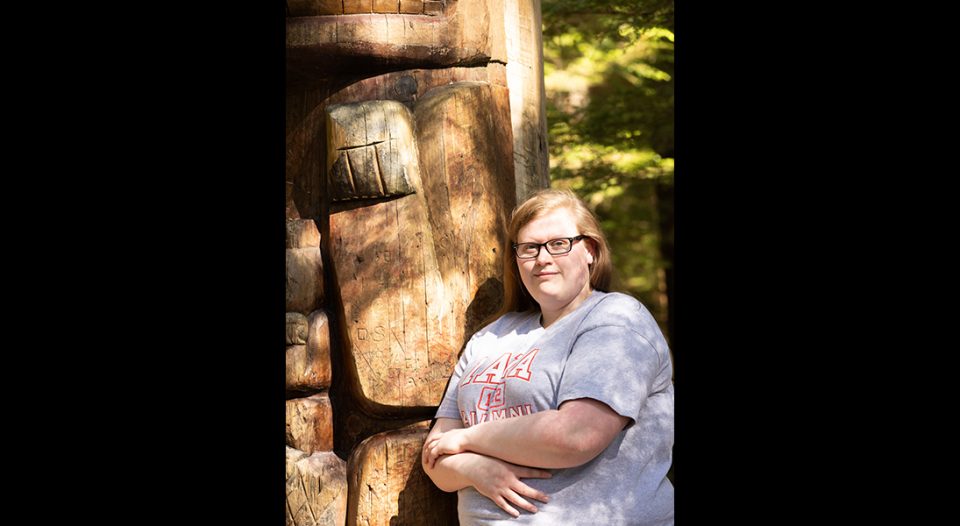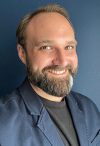Sitka (Alaska) Lutheran Church
Collections manager, Kodiak History Museum
I was baptized and confirmed at Sitka Lutheran and made my decision there to “live Lutheran,” as it were. I attended Christ Lutheran Church in Santa Fe, N.M., [while] I completed my Bachelor of Fine Arts degree at the Institute of American Indian Arts, which I did last year—I consider both Sitka Lutheran and Christ Lutheran my ecclesiastical homes.
Being part of a church community, and specifically a Lutheran church community, feels like home to me. No matter where, as long as I have an ELCA Lutheran community in town I feel like I’m at home. When you’re at an ELCA church, we all kind of have the same footing.
Part of that is because of the Reconciling in Christ program. I describe myself as pansexual or androsexual. Being around people who are accepting of that and accepting of the fact that I also believe in Christ and I believe in the tenets of Martin Luther, no matter where I’m living, is so important to me.
I first began serving on church council at Sitka in 2016. In 2018 I became church council president, where I served until 2022. I wanted to do a lot more, but I was doing school full time; I worked part time while taking full-time college classes online.
Prior to serving on church council, I was on a number of nonprofit boards and was on student government at the University of Alaska Southeast, where I began college. I was able to do a lot of things within those leadership positions, and it imparted for me the importance of doing that, because a lot of churches and any nonprofit are only as strong as their church council or board is. It’s hard to find board members and leaders in faith communities, for a variety of reasons. I wanted to step into that role because, especially as a younger person, being able to take some of the reins of the church and being able to continue the church legacy … was very important to me.
Having dyslexia is just a different neurodiverse type and [way] of understanding. I think it makes me a stronger leader because I’ve had to think outside the box about how I can get information into my brain. Dealing with making things accessible, I’m always thinking about everyone’s needs. On church council, I was trying to work with people and figure out where the church can accommodate them.
I am a massive history buff. It seeps into every part of my being and out of every part of my life—and it started in the church. When I was younger, we learned about the history of Alaska, including Princess Maksutov, one of the Russian princesses. And then at Christmas and in Sunday school, we heard about Jesus. I thought, “OK, you have Princess Maksutov at this time, and you have Jesus at this time. What was happening in between? Now I have to fill in every gap.”
Having dyslexia is just a different neurodiverse type and [way] of understanding.
I got interested in museum work because I wanted to have the opportunity to study history every single day. In my schooling and through my degree, I heard about what a collections manager was, and I thought [that] it’s a little bit of everything I want to do: work directly with the collections, study a little bit of history, and be in the museum fields and around amazing exhibits and conversations.
A collections manager is the steward of a museum’s collections. We do some registrar work, but generally my job is to manage the collections and take care of them. I get unbridled access to a museum collection, which is like being a kid in a candy store. Today I was reviewing an incoming donation of letters. I’m hearing their perspectives, and I’m able to read these letters and get a full-on, in-person view of history—more specifically, Kodiak history—and it’s so enlivening.
At the Kodiak History Museum our collection is very broad. We have everything from letters to taxidermy to Orthodox icons. We have a number of Russian icons in our collection—being able to care for somebody’s religious icons is powerful. We have old glass plate negatives. We have a ton of paintings. We have household goods in general. You’ve got a doctor’s bag. We’ve got all sorts of really fun and cool and interesting things in our collection, and it’s all my purview.
My focus on Native American art began with a class on Native American art history, and then it just started growing. In a lot of Indigenous cultures there’s no actual word for art—it doesn’t exist, because art was everything, they decorated everything. As a person who is deeply spiritual and has a Lutheran understanding of the presence of God and the Spirit, I found Native American art [so] soulful. They took on a different level spiritually than a lot of other artworks in their understanding of the sacred. There’s this idea in Christianity that everything is sacred, and it’s the same thing within Indigenous communities, that everything is sacred. And art is probably one of the more sacred things.
There’s a belief and an understanding that, in totem poles and Native masks, those masks have a spirit to them. As a person who grew up in the church, I had an understanding that the chalice and the things that we use for the sacraments have a deep spiritual power within them. There’s the same power in Native American art, with the same reverence we have in those pieces.
In much the same way that pastors feel called to serve, I feel called to studying Native American art. Part of that is [about] healing. I think the church has a lot it needs to atone for. The more I work with Native American art, the more I try to understand how, as a church, we can learn to repent and seek forgiveness for the wrongs the church has done. I look at the history of how Lutheran churches and other sects of Christianity have acted toward Indigenous people and how we can heal from that and make amends.
In Indigenous thought medicine means so much more than going to the doctor’s office and getting Sudafed or Tylenol. There are other ways to heal, and that includes through the arts. It also includes singing and going to church. It’s all medicine. And being able to lift that up and see how Indigenous peoples have used art as a part of their way of life and as part of their everyday occurrence, and how we can make the sacred in everything, has been such a calling for me.
That’s basically what the job is—to assign meaning.
I see the sacred in Lutherans’ practices with quilting and bedding. I see Quilts to Comfort groups and think that’s medicine. That’s what the Indigenous mean when they talk about medicine. Something horrific happens, like a natural disaster, and you have these quilts that are beautifully put together by family members going out to people. That is a version of medicine.
I served as an interpretive ranger with the national parks from 2022-2023. There’s an agreement between the National Park Service and the state of Alaska that a certain portion of National Park Service employees must be from Alaska. I was a local-hire interpretive ranger, and in some ways the role is very much like a pastor. We’re the go-between with the park itself, the objects in the park and the people, and we tell them how important these things are. Pastors read the Scripture and, in their sermons, describe how that Scripture affects their life and can help them—and it’s the same thing with objects and history. My job as an interpretive ranger was to interpret the park.
As a ranger in Sitka National Historical Park, where we have totem poles, I would tell about the stories, the sacredness of them, to people who didn’t know [about them]. They would come in and see carved pieces of wood. But as soon as you get a chance to tell them what this pole means and why it’s important and what it was used for, their perspective and their interaction with them changes. When I talked about how these poles were erected, how they were carved and the man-hours it took, the respect deepened. That model gives them the interpretive opportunity to learn at a deeper level and to be able to assign meaning to things. That’s basically what the job is—to assign meaning. The same is true for me as a collections manager.
What I’ve learned in my vocation is that connections are everywhere for everything, and we’re all connected. I have this need to connect the meaning of an object to the pieces I take care of. And it deepens the connection and helps me know why I’m stewarding it. It first deepened my appreciation and my ability to do my job on a more emotional, spiritual level, then on a day-to-day level.
I pray for a lot. When you look at Luther’s catechism there are prayers for the beginning of the day and the end of the day. I want to do that and be a good Lutheran—but I don’t really want to do a big, fancy email at the end of the day, because I feel like I’m always spiritually texting God. I have constant conversations with God throughout the day. But for Luther’s time it makes sense.
Grace, to me, means patience, forgiveness and understanding.
I’m a Lutheran because I enjoy sinning boldly! Ultimately, I just agree with the tenets of Lutheranism. I agree with Luther and his ideas. I view Lutheranism as a pair of glasses—and this is the pair of glasses I feel like I see Christianity best through and I understand Christ through, that matches my personality, and matches how I believe in and view God.
If you’d like to nominate someone for “I’m a Lutheran,” email livinglutheran@elca.org.






